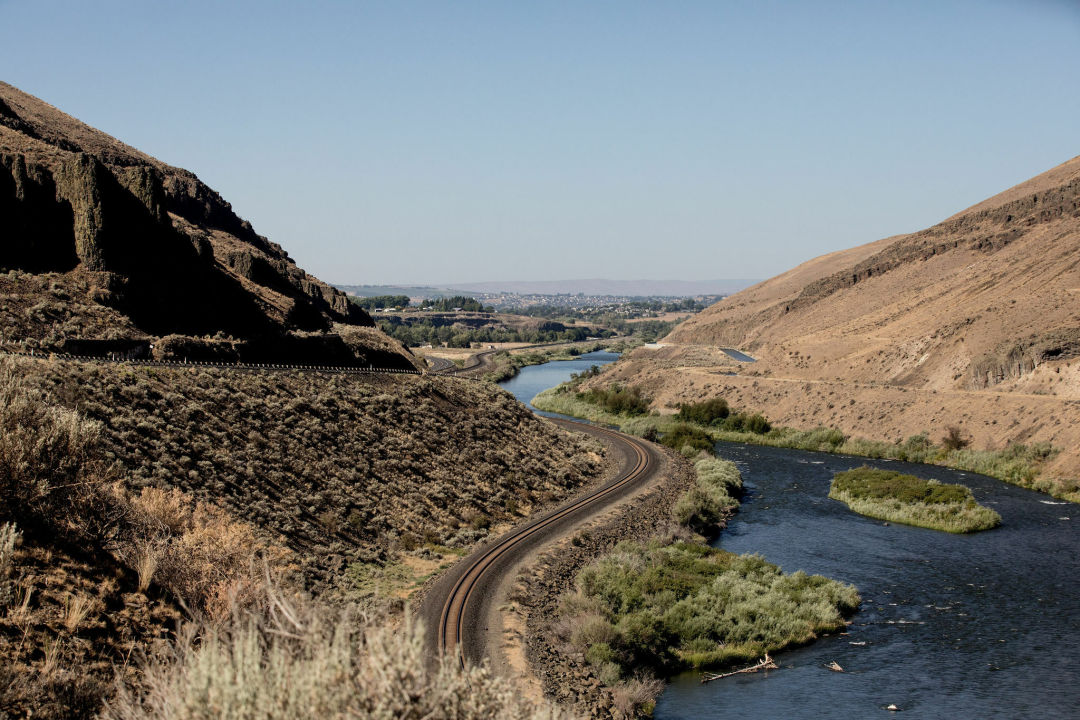What to Do in Yakima

The Yakima River cuts through the dry Central Washington landscape.
Image: Brooke Fitts
The sun is always shining—well, almost always—in Central Washington’s rich agricultural valley, where nearly every form of recreation is about enjoying the great outdoors or the bounty of its fields and streams. Follow the horizon for views of Mount Adams or the rolling grasslands and basalt cliffs, or wander the small town streets on the south end of the Yakima Valley. Just don’t forget the sunscreen.
Yakima River Fly-Fishing
Cut north-south into the empty acreage of Central Washington, the Yakima River Canyon glows with the rich blue of a waterway rich in fish. Fly anglers flock here year-round, dancing their colorful fake insects over the surface of the water in hopes of catching trout. Located about halfway between Ellensburg and Yakima, Red’s Fly Shop (and the next-door Canyon River Ranch hotel) is the ideal fishing base camp, offering guided trips and boat rentals.
Cowiche Canyon Trails
Overseen by the Bureau of Land Management and a dedicated conservancy, Cowiche Canyon’s trail system encompasses 13 miles within the rugged landscape just west of Yakima. The canyon walls are lined with basalt and andesite, stunning evidence of how historic floods and volcanic activity shaped the now-placid acreage. At one time a railroad ran through here, but now unpaved routes wind through wildflowers and shrubland. Keep an eye out for butterflies.

Cowiche Canyon trails burst with color in fall.
Artsy Tieton
Welcome to Mighty Tieton, an arts facility in a town so tiny it looks like a film set. Founded when Seattle art publisher Ed Marquand’s bike tires blew out in front of some empty fruit warehouses, the endeavor is a small complex of studios, work-live spaces, galleries, and print shops. With an advance request, a staff member will lead a tour through former apple storage rooms that now hold hand-printed books and a repository for the Seussian music sculptures of the sound artist Trimpin. The space also holds regular public events and workshops.
Beer and Cider
The Yakima Valley has long been known for its hops; by some estimates it produces three-quarters of the country’s output. So it’s no wonder there’s plenty to drink. At Bale Breaker, a brewery founded by siblings in the middle of their family’s hops farm, the ingredients for their signature IPAs are just out the back door. When it’s time to brew a fresh-hop beer, the owners back their truck up to their parent’s crop picker and start cooking only six minutes after the buds leave the vine. Yakima Craft Brewing, on the other hand, specializes in Belgian styles, bringing a worldly menu to the small city. Cideries continue making a name for themselves in town as well, particularly Tieton Cider Works, which holds concerts on its patio in summer.
Toppenish Murals
Keep your eyes peeled in tiny Toppenish, where large paintings cover the exterior walls of local businesses. This unexpected art depicts everything from the history of small town life to, in one, a bear fighting a man. Since the Mural Society was formed in 1989, members have generated almost 80 different art pieces, including ones created in a single day during the annual summer celebration. Since most paintings are concentrated downtown, a walking tour is the easier way to peruse. When the heat becomes overwhelming, the American Hop Museum (dedicated to the beer making ingredient) and the Northern Pacific Railway Museum (in the town’s old depot) both offer indoor shade.
Fort Simcoe Historical State Park
Located within the Yakama Indian Reservation, Fort Simcoe has a long and complicated history. It was built before the Civil War, back when skirmishes arose between the Indigenous locals and arriving settlers. In 1859, it became a boarding school for Yakama Nation children, part of a residential school legacy fraught with family separation, cultural loss, and harsh treatment. Today, the state leases the property from the Yakama Nation, putting history on display in an interpretive center and preserving beautiful historic buildings.




